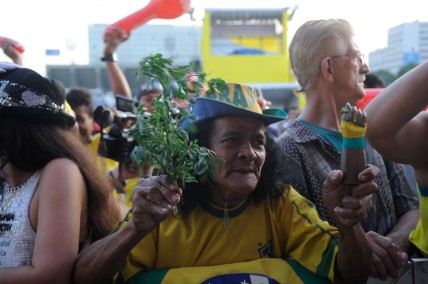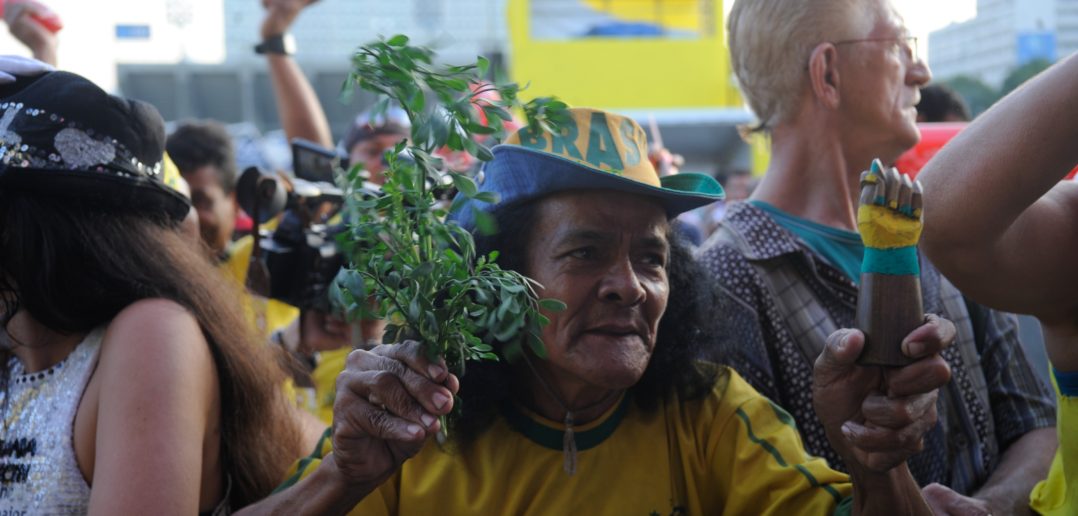
Around 6,000 people gathered together in Rio de Janeiro city to root for the Brazilian football team in the Confederations Cup. Photograph by Tomaz Silva/ABr
It was another day to wear green and yellow t-shirts in the streets of Brazil, but for very different reasons.
For some, the national colors were to root for the home team. For others, the shirts were to demand for political and social changes and to face theviolence of military police [pt].
On the same day that Brazil’s national football team secured a place in the Confederations Cup final, protests occurred in at least 18 cities [pt]on Wednesday, 26 June. Outside the Mineirão Stadium in Belo Horizonte city, where Brazil beat Uruguay 2-1, nearly 40,000 [pt]gathered for a protest organized by the Comitê Popular dos Atingidos pela Copa (Popular Committee for People Affected by the Cup), known as COPAC, and joined [pt]by other social movements such as the Movimento dos Trabalhadores Rurais Sem Terra (Landless Worker Movement) and the Movimento Atingidos por Barragens (People Affected by the Dam Movement).
One person died [pt]after falling from the top of a viaduct, and a fall of a second man was also reported. At least 25 people were arrested and another 25 wounded. A car shop was set fire andappliance shops were looted.
The mixed feeling of the nation could be seen on Twitter:
Brazilian attacking midfielder Lucas Moura (@LucasnaRede_) wrote:
@LucasnaRede_: Let’s go for another battle! #VaiBrasil(#GoBrasil) http://instagram.com/p/bB-MUuIwPB/
Twitter user Nina Pires (@ninapires_) said she was nervous during the match:
@ninapires_What a tense match #vaiBrasil (Go Brazil) another goal, let’s go!!!
But the situation was summed up well by Twitter user Luiz Gusttavo Senner (@gusttavosenner):
@gusttavosenner: While the #Minerão is on fire inside the protests are on fire outside on the streets of #BH (Belo Horizonte)
On the battle outside the pitch in Belo Horizonte, the demonstration that started peaceful turned violent. COPAC’s statement on Facebook [pt]explaining what happened has over 7,390 likes:
COPAC PUBLIC STATEMENT: IF SOMEONE IS TO BE BLAMED, BLAME FIFA!
The Popular Committee for People Affected by the Cup actively participated in another march in Belo Horizonte city for the rights of people and against the violations and privatization of the public space for the mega event FIFA Confederations Cup in course.
The march happened in a quiet and peaceful way until it reached Abraão Caram Avenue, when a major conflict began between protesters and military police. Protesters from social movements and COPAC made a human chain to isolate the access to a metal fences barrier imposed by FIFA and the state government, but some people shook the barrier and the police retaliated on all protesters by dropping “moral effect” bombs, tear gas and shooting rubber bullets. We consider that the fact that people broke FIFA’s fences is related to the social unrest against mega events organizations which have a strong private and elitist character in a country marked by many social inequalities and other priorities.
Yes, we disavow the barrier imposed because it is illegitimate, as it restricts people from their city spaces in favor of FIFA’s and its partner companies’ voluptuous profits…
A Twitter profile under the name @meiodabeirada criticized police for not being able to deal with the group who vandalized the protest:
@meiodabeirada : THE POLICE CAN’T GUARANTEE SAFETY, CAN’T THEY? THEY ARE ONLY A FEW [who broke through the barrier]. THE MAJORITY FOLLOWED THROUGH THE ANTONIO CARLOS AVENUE. #PROTESTOBH pic.twitter.com/PNhUwZtFSo
On the other hand, Twitter user Luiz Carlos Garrocho (@lc_garrocho) questioned:
@lc_garrocho: Is it vandalism to confront a barrier? But what’s the point to demonstrate so far away from the stadium? #protestobh
Dilma’s Five Points
Meanwhile in Brasilia, the National Congress made some major decisions. On Wednesday, 26 June, a bill that makes passive and active corruption a heinous and non-bailable [pt]crime passed the Senate, and will continue on to the Chamber of Deputies and the president.
The day before, the Chamber of the Deputies had rejected a controversial proposed constitutional amendment – PEC 37- dubbed as the“bill of impunity”. They alsocancelled [pt]the budget of 43 million Brazilian reais (about 20 million US dollars) that would be allocated to the Ministry of Communication to spend on technology for video broadcast and real data transport during the World Cup.
On the same day, the Chamber of the Deputies approved that 75 percent of the royalties of Brazil’s Pre-Salt oilfields should be allocated [pt]to education, and 25 percent to the health system.
This series of measures prompted famous Brazilian columnist José Simão (@jose_simao) to make the following joke:
@jose_simao: The Congress is looking like a widow who has a 10-year back-up to catch up on
Brazilian President Dilma Rouseff announced [pt]reforms in five areas: public transport, political reform, health care, fiscal responsibility, and education on Monday, 24 June and is to call a referendum to implement a political reform in the country. For the topic that started up the demonstration in the streets, public transport, the government has signaled a package of 50 billion reais (about 23 billion US dollars). Roussef had a meeting with all Brazilian city mayors, state governors and member of the Free Fare Movement, the force which organized the first protests of what became the Vinegar Revolt later, on the same day.
Some [pt]have pointed out that the government has dismissed the fact that inflation has returned in Brazil.
Written by Thiana Biondo




